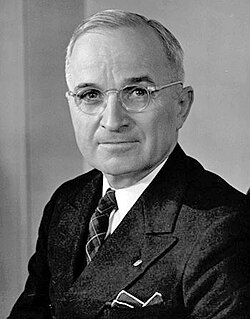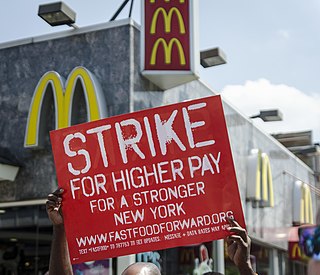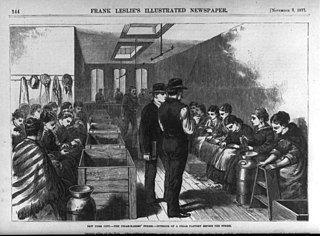Wage slavery describes a person's dependence on wages or a salary for their livelihood, especially when wages are low, conditions are poor, and there are few realistic chances of upward mobility. The term is often used by critics of work to criticize the exploitation of labor and social stratification, with the former seen primarily as unequal bargaining power between labor and capital, particularly when workers are paid comparatively low wages, such as in sweatshops, and the latter is described as a lack of workers' self-management, fulfilling job choices and leisure in an economy. The criticism of social stratification covers a wider range of employment choices bound by the pressures of a hierarchical society to perform otherwise unfulfilling work that deprives humans of their "species character" not only under threat of extreme poverty and starvation, but also of social stigma and status diminution. Historically, many socialist organisations and activists have espoused workers' self-management or worker cooperatives as possible alternatives to wage labor.

The labor history of the United States describes the history of organized labor, US labor law, and more general history of working people, in the United States. Beginning in the 1930s, unions became important allies of the Democratic Party.
The textile workers' strike of 1934 was the largest strike in the labor history of the United States at the time, involving 400,000 textile workers from New England, the Mid-Atlantic states and the U.S. Southern states, lasting twenty-two days.

The Lawrence Textile Strike, also known as the Bread and Roses Strike, was a strike of immigrant workers in Lawrence, Massachusetts, in 1912 led by the Industrial Workers of the World (IWW). Prompted by a two-hour pay cut corresponding to a new law shortening the workweek for women, the strike spread rapidly through the town, growing to more than twenty thousand workers and involving nearly every mill in Lawrence. On January 1, 1912, the Massachusetts government enforced a law that cut mill workers' hours in a single work week from 56 hours, to 54 hours. Ten days later, they found out that pay had been reduced along with the cut in hours.

The 1913 Paterson silk strike was a work stoppage involving silk mill workers in Paterson, New Jersey. The strike involved demands for establishment of an eight-hour day and improved working conditions. The strike began in February 1913, and ended five months later, on July 28. During the course of the strike, approximately 1,850 strikers were arrested, including Industrial Workers of the World (IWW) leaders Bill Haywood and Elizabeth Gurley Flynn.

The Lowell mill girls were young female workers who came to work in textile mills in Lowell, Massachusetts, during the Industrial Revolution in the United States. The workers initially recruited by the corporations were daughters of New England farmers, typically between the ages of 15 and 35. By 1840, at the height of the Textile Revolution, the Lowell textile mills had recruited over 8,000 workers, with women making up nearly three-quarters of the mill workforce.
Sarah George Bagley was an American labor leader in New England during the 1840s; an advocate of shorter workdays for factory operatives and mechanics, she campaigned to make ten hours of labor per day the maximum in Massachusetts.

The minimum wage in the United States is set by U.S. labor law and a range of state and local laws. The first federal minimum wage was instituted in the National Industrial Recovery Act of 1933, signed into law by President Franklin D. Roosevelt, but later found to be unconstitutional. In 1938 the Fair Labor Standards Act established it at $0.25 an hour. Its purchasing power peaked in 1968, at $1.60. Since 2009, it has been $7.25 per hour.

Roger Lowell Putnam was an American politician and businessman. A member of the prominent Lowell family of Boston, he served as Mayor of Springfield, Massachusetts, from 1937 until 1943, and as director of the Economic Stabilization Administration from 1951 until 1952. During his short tenure in federal office, the nation's steelworkers struck—leading United States President Harry S. Truman to seize the nation's steel mills.

The 1952 steel strike was a strike by the United Steelworkers of America (USWA) against U.S. Steel (USS) and nine other steelmakers. The strike was scheduled to begin on April 9, 1952, but US President Harry Truman nationalized the American steel industry hours before the workers walked out. The steel companies sued to regain control of their facilities. On June 2, 1952, in a landmark decision, the US Supreme Court ruled in Youngstown Sheet & Tube Co. v. Sawyer, 343 U.S. 579 (1952), that the President lacked the authority to seize the steel mills.

The Lowell mills were 19th-century textile mills that operated in the city of Lowell, Massachusetts, which was named after Francis Cabot Lowell; he introduced a new manufacturing system called the "Lowell system", also known as the "Waltham-Lowell system".
The 1835 Paterson textile strike took place in Paterson, New Jersey, involved more than 2,000 workers from 20 textile mills across the city. The strikers, many of whom were children and of Irish descent, were seeking a reduction in daily working hours from thirteen and a half hours to eleven hours. Support from other workers in Paterson and nearby cities allowed the strikers to sustain their efforts for two weeks. Employers refused to negotiate with the workers, and were able to break the strike by unilaterally declaring a reduction in work hours to twelve hours daily during the week and nine hours on Saturdays. Many leaders of the strike and their family were blacklisted by employers in Paterson after it ended.
The Voice of Industry was a worker-run newspaper published between 1845–1848, at the height of the American Industrial Revolution. The Voice was centrally concerned with the dramatic social changes wrought by the Industrial Revolution, as workers came to depend on corporations for a wage.

The Fight for $15 is an American political movement advocating for the minimum wage to be raised to USD$15 per hour. The federal minimum wage was last set at $7.25 per hour in 2009. The movement has involved strikes by child care, home healthcare, airport, gas station, convenience store, and fast food workers for increased wages and the right to form a labor union. The "Fight for $15" movement started in 2012, in response to workers' inability to cover their costs on such a low salary, as well as the stressful work conditions of many of the service jobs which pay the minimum wage.

Export-oriented employment refers to employment in multinational corporations' international industrial factories, usually located in developing countries. Such factories produce goods and services for sale in other countries. While these multinational producers have globally expanded women's access to employment, evidence suggests they do so by reinforcing traditional gender roles or creating new gender inequalities. Such gender inequities allow multinational firms to greater exploit profits per worker than they would otherwise due to the decreased labor cost. This decrease in the cost of labor comes as a result of the relegation of women to certain occupations. Studies show that in the quest for lower unit labor costs, export-oriented facilities create poor working conditions.

The cigar makers' strike of New York lasted from mid-October 1877 until mid-February 1878. Ten thousand workers walked out at the height of the strike, demanding better wages, shorter hours and better working conditions, especially in the tenement manufacturing locations. The strike was supported by the Cigar Makers International Union of America, local chapter 144.

The 1928 New Bedford textile strike was a mass work stoppage of approximately 30,000 machinery operatives in several of the large cotton mills located in New Bedford, Massachusetts, USA. The strike, which ran for several months during the spring and summer of 1928, is remembered for the prominent role played by the Workers (Communist) Party of America in mobilizing the immigrant workers of the region.
The New England Shoemakers Strike of 1860 began on February 22, 1860 with 3,000 shoemakers walking off their jobs in Lynn, Massachusetts. It ended in April with modest gains for shoemakers, including pay increases and owner recognition of some labor unions. Approximately 20,000 workers went on strike across New England which made it the largest mass walkout in American history prior to the Civil War.

Women in labor unions have participated in labor organizing and activity throughout United States history. These workers have organized to address issues within the workplace, such as promoting gender equality, better working conditions, and higher wages. Women have participated in unions including the Collar Laundry Union, the WTUL, the IWW, the ILGWU, and the UAW.

The 1911 Grand Rapids furniture workers' strike was a general strike performed by furniture workers in Grand Rapids, which was then a national leader of furniture production.













